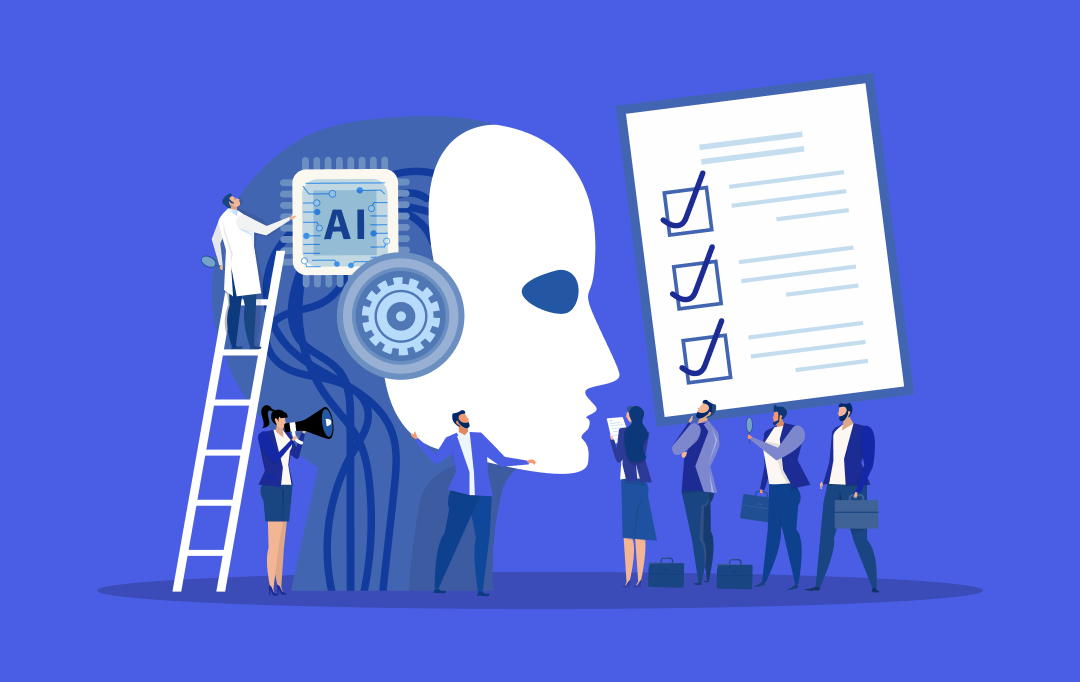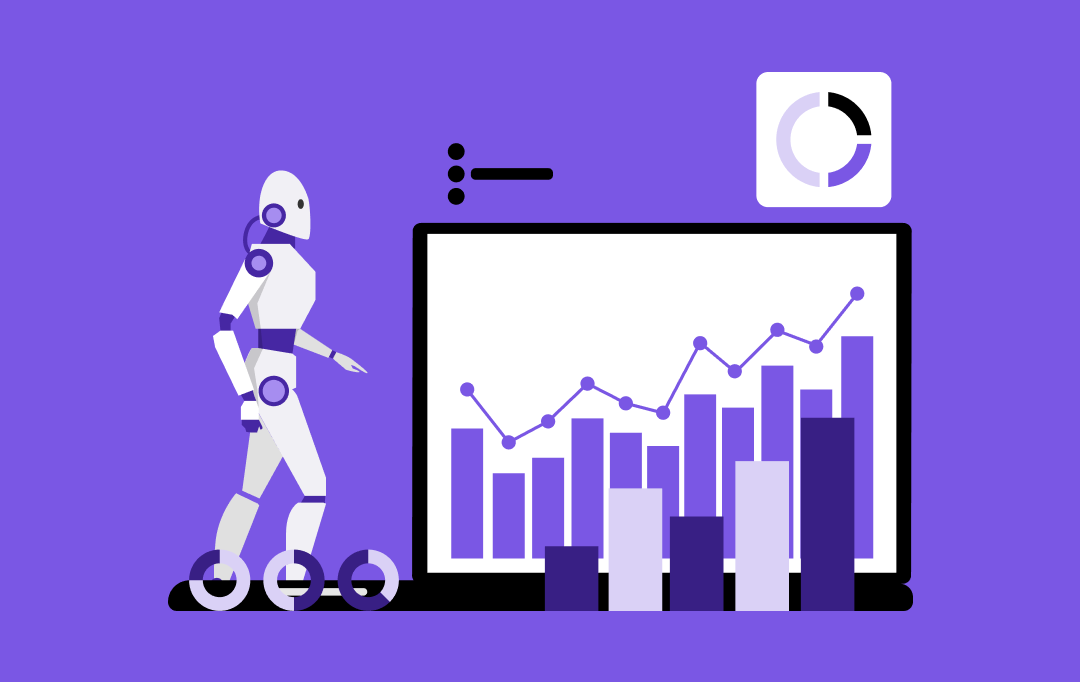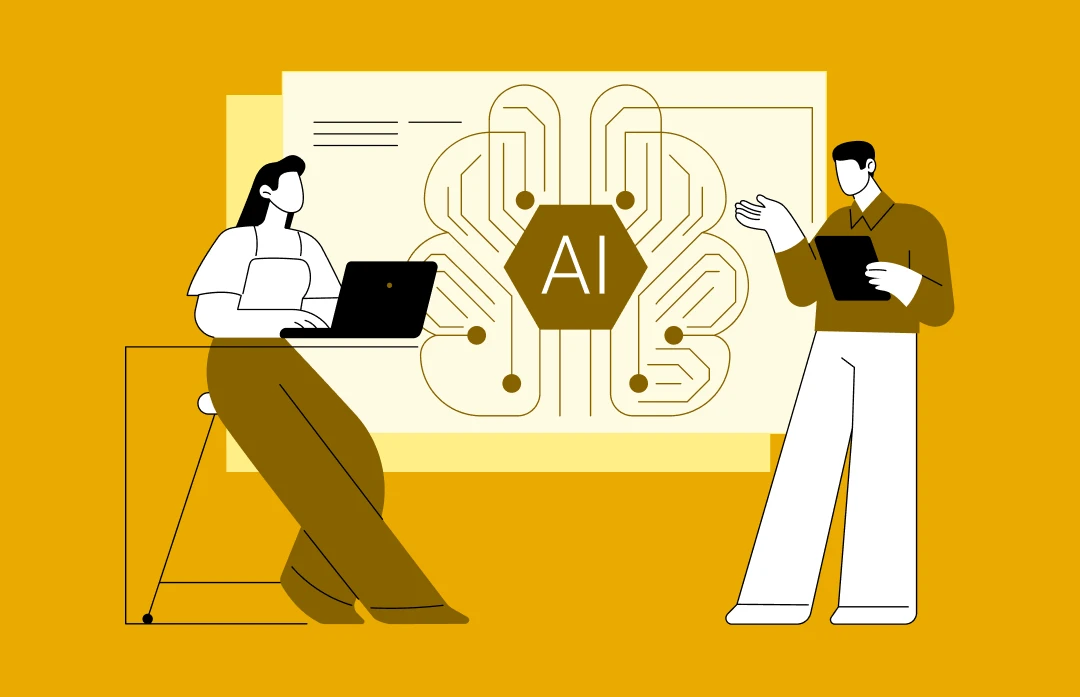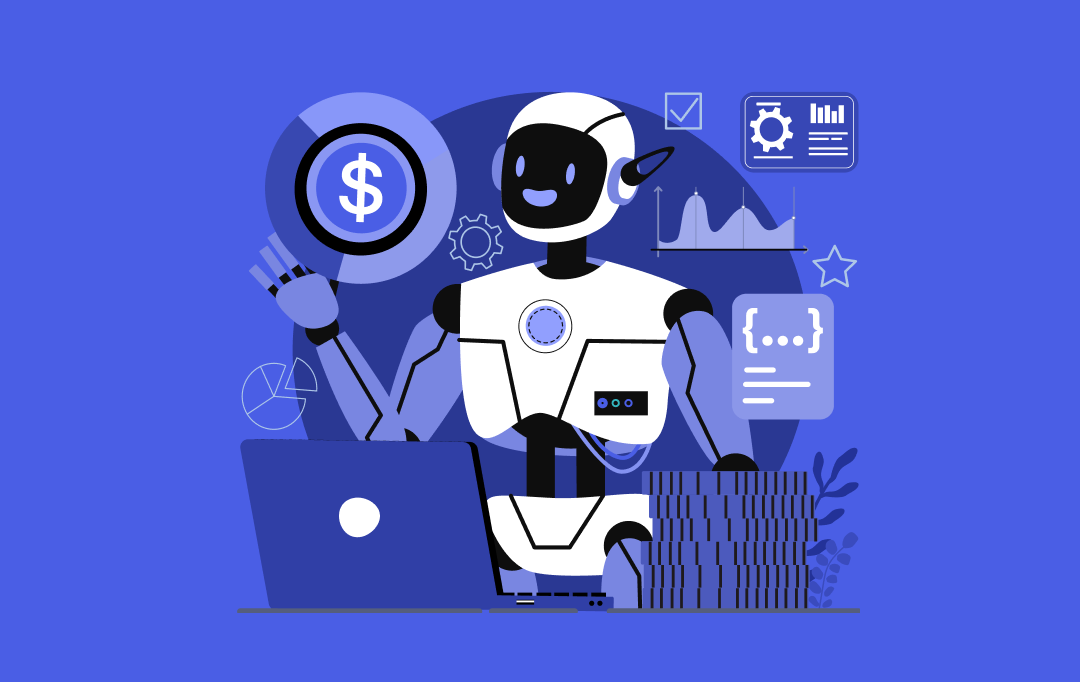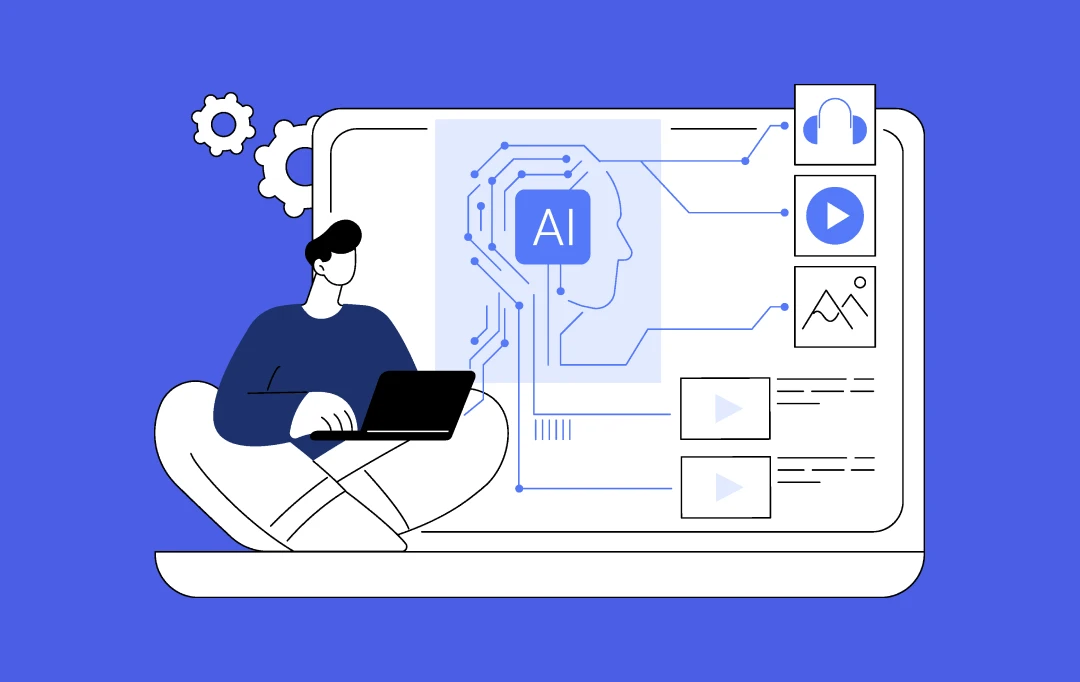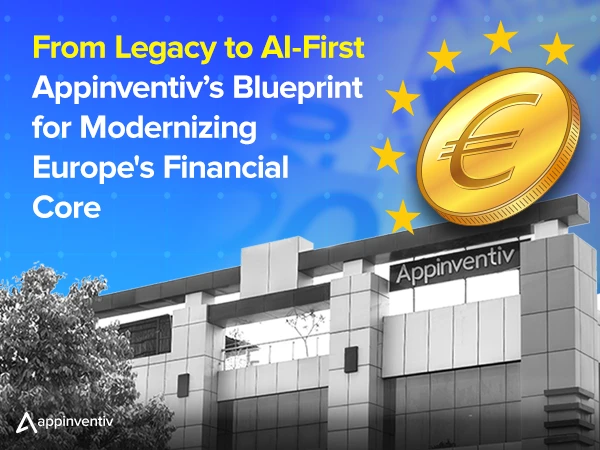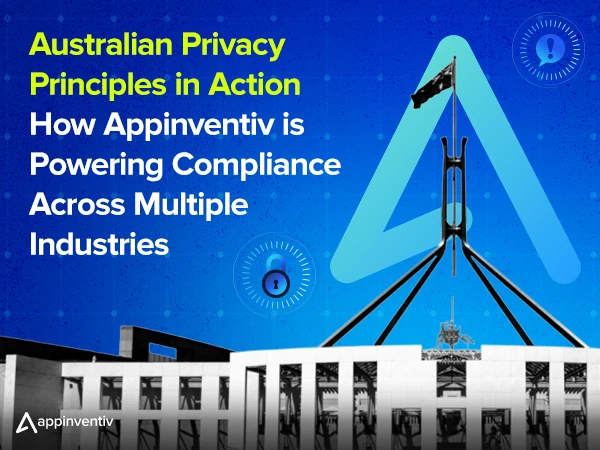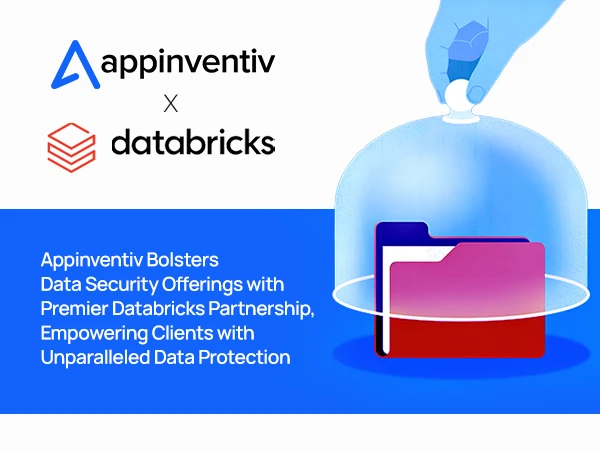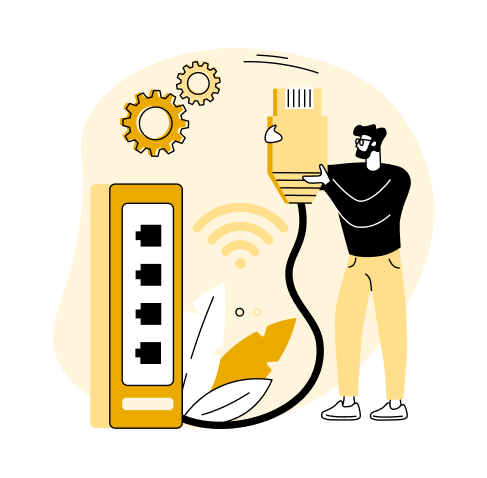- A Glimpse into the Automotive IoT Market: The Next Big Innovation Driving the Auto Industry Forward
- Understanding the Architecture of IoT-Powered Automotive Vehicles
- 1. Perception Layer (The Sensing Level)
- 2. Network Layer (The Communication Bridge)
- 3. Data Processing Layer (The Brain of the System)
- 4. Application Layer (The User Interface)
- Advantages of IoT in the Automotive Industry
- Predictive Maintenance
- Connected Vehicles
- In-Vehicle Infotainment
- Smart Infrastructure
- Fleet Management
- Use Cases of IoT in the Automotive Industry
- Autonomous Vehicles
- Driver and Fleet Management
- Real-Time Vehicle Telematics
- Software Updates
- Cellular Vehicle To Everything (CV2X)
- Monitor the Driver’s Condition
- Real Examples of Automotive Companies Using IoT-Based Solutions
- Tesla
- Ford
- BMW
- General Motors (GM)
- Volkswagen
- Toyota
- Addressing the Challenges of Connected Cars: Effective Solutions and Strategies
- Network Reliability
- Data Management and Integration
- Security and Privacy Concerns
- Cost of Implementation
- Future of Automotive IoT: What Businesses Can Expect
- 1. Predictive Maintenance Will Become the Industry Standard
- 2. Connected Supply Chains Will Drive Faster Manufacturing
- 3. Vehicle-to-Everything (V2X) Communication Will Take Off
- 4. Data Monetization Will Unlock New Revenue Streams
- 5. Over-the-Air (OTA) Updates Will Redefine Customer Support
- 6. The Rise of Mobility-as-a-Service (MaaS)
- How Appinventiv Can Help Leverage Automotive IoT
- FAQs
Key takeaways:
- IoT is revolutionizing operations across the automotive industry.
- Predictive maintenance powered by IoT is now a key competitive advantage.
- IoT streamlines supply chains and enhances production efficiency.
- Vehicle-to-everything (V2X) communication enables safer, smarter mobility networks.
- Data from connected vehicles is creating new monetization opportunities.
- Over-the-air (OTA) updates are transforming post-sale customer engagement.
- IoT is driving the transition toward shared and connected mobility ecosystems.
Have you ever dealt with unexpected vehicle breakdowns, inefficient supply chains, rising maintenance costs, or the constant struggle to meet customer demands for faster, smarter services? If you’re in the automotive space, you probably have—and you know just how costly and frustrating these problems can be.
This is exactly where automotive IoT changes the game. It’s not just about connecting cars to the internet—it’s about connecting your entire automotive ecosystem. From manufacturing plants to fleets on the road, IoT in the automotive industry helps businesses track, analyze, and optimize everything in real-time.
With smart sensors, GPS, cloud systems, and connected devices working together, you get instant visibility into vehicle health, driving patterns, fuel usage, and supply chain performance. This kind of proactive data isn’t just useful—it’s essential for businesses looking to cut costs, prevent downtime, and offer standout customer experiences.
But it doesn’t stop there. Automotive IoT is paving the way for predictive maintenance, intelligent traffic management, autonomous driving, and seamless fleet operations. It’s transforming how cars are built, sold, and driven.
In this blog, we’ll break down:
- Why automotive IoT matters for businesses today
- Key applications that are already driving real impact
- Real-world examples of how industry leaders are using IoT to win
A Glimpse into the Automotive IoT Market: The Next Big Innovation Driving the Auto Industry Forward
Automotive IoT is no longer just about adding sensors to cars—it’s actively reshaping how businesses build, sell, and manage vehicles. From enabling predictive maintenance and improving manufacturing precision to creating smarter, safer, and more personalized driving experiences, IoT is helping companies solve real problems while unlocking new business opportunities.
IoT in the automotive industry is also changing the way businesses manage entire fleets, monitor vehicle health in real time, reduce downtime, and offer value-added services that keep customers loyal. It’s not just an upgrade—it’s fast becoming the foundation of modern automotive success.
So, Why Now Is the Right Time to Invest in Automotive IoT?
The automotive industry is reaching a tipping point. Companies that adopt IoT today are not just improving their processes—they’re getting ahead of the competition by building smarter, more connected ecosystems that will define the next generation of mobility.
The market signals are clear:
- The average electronics revenue per IoT endpoint across enterprise and automotive is projected to hit $317 by 2032 (source: Gartner), showing that businesses will increasingly rely on high-value IoT-enabled components and systems to drive profitability.
- The Automotive IoT market is expected to reach $274.70 billion by 2025, and grow at a solid 7.85% CAGR to hit $371.61 billion by 2029 (source: Statista). This is not a niche—it’s a fast-growing global market that businesses can no longer afford to ignore.
- McKinsey predicts that by 2030, over 90% of vehicles sold will be connected, compared to around 50% today. This shows that connectivity is quickly becoming the new standard, not an optional feature.
These numbers are more than just projections—they’re a wake-up call. The companies that act now will be the ones leading innovation, building stronger customer relationships, and gaining long-term market advantages
After looking into the IoT in automotive industry market trends and insights, let’s move ahead and look at the end-to-end IoT architecture for automotive applications and vehicles.
Understanding the Architecture of IoT-Powered Automotive Vehicles
Ever wondered how connected vehicles actually work behind the scenes? It’s not just about sensors and apps—it’s a carefully layered system where hardware, software, and cloud services work together in real time.
At the core, the architecture of IoT-powered automotive vehicles is built on four key layers:
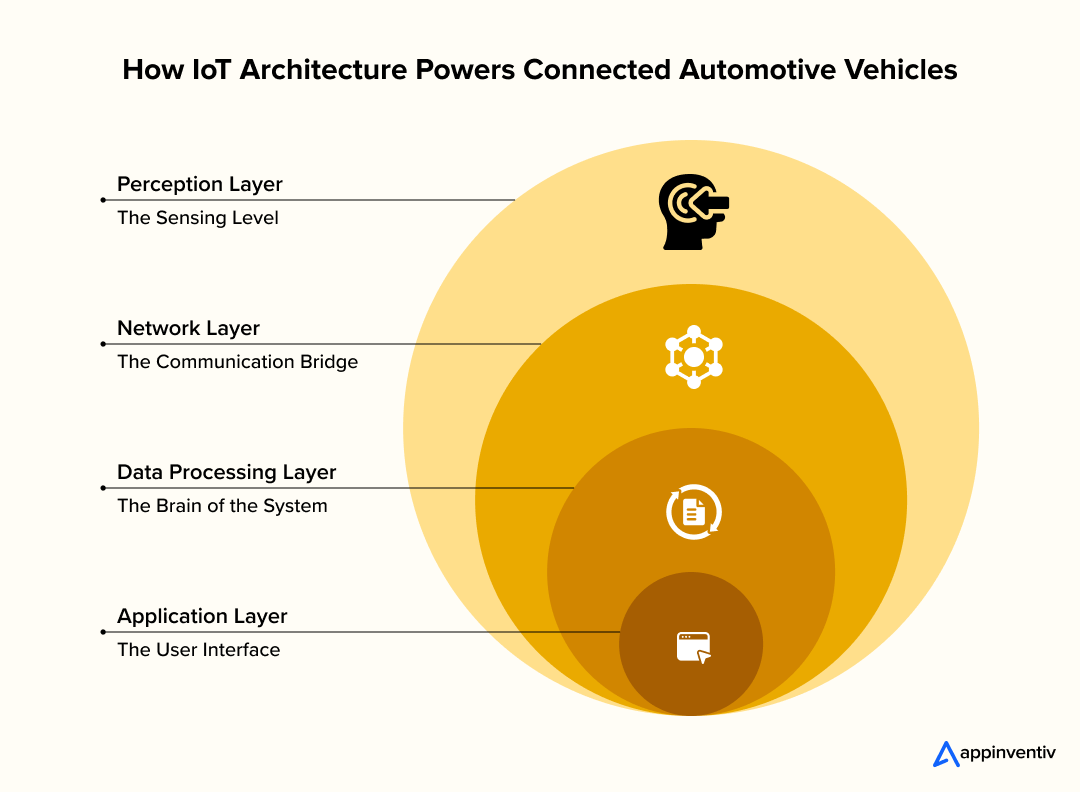
1. Perception Layer (The Sensing Level)
This is where real-world data collection happens. Devices like sensors, GPS units, cameras, and RFID tags constantly gather information about the vehicle’s condition, surroundings, and driver behavior. Whether it’s tracking speed, engine temperature, tire pressure, or nearby obstacles, this layer acts as the eyes and ears of the connected vehicle.
2. Network Layer (The Communication Bridge)
The data collected needs to go somewhere. The network layer transmits data from the vehicle to the cloud, control centers, or other connected systems using technologies like Wi-Fi, 4G/5G, Bluetooth, or dedicated short-range communication (DSRC). This layer ensures seamless, real-time data flow between the vehicle, infrastructure, and external systems.
3. Data Processing Layer (The Brain of the System)
Once the data reaches the cloud or edge devices, it gets processed, analyzed, and converted into actionable insights. This is where predictive analytics, machine learning, and artificial intelligence kick in to help detect patterns, optimize performance, and enable real-time decision-making like collision warnings or route adjustments.
4. Application Layer (The User Interface)
This is the visible layer that drivers, manufacturers, and fleet managers interact with. It includes vehicle dashboards, fleet management portals, mobile apps, and real-time alerts that provide insights, safety updates, and system controls in an easy-to-use format.
Advantages of IoT in the Automotive Industry
The Internet of Things allows for easier, faster, and more secure communication and data distribution between computers and connected devices, benefiting industries worldwide, and the automotive sector is no exception.
Let’s discuss in detail the benefits of IoT in the automotive industry.

Predictive Maintenance
When it comes to vehicle maintenance, there are two approaches – preventive and predictive. And predictive maintenance always goes a step ahead of the preventive. With automotive IoT, one can monitor the status of cars and all connected devices in real-time and predict when the vehicles require maintenance, preventing any serious issue from occurring or resolving a pertinent one before it turns critical.
Connected Vehicles
One of the most remarkable benefits of Automotive IoT is CV2X (cellular vehicle to everything), connecting smart transport systems and vehicles with each other. With the incorporation of IoT in the automobile industry, vehicles can share relevant information, like location, route, speed, etc., in real-time, managing traffic flow and reducing the risk of collisions or accidents.

In-Vehicle Infotainment
Besides preventing accidents and maintaining vehicles, IoT-enabled in-vehicle infotainment systems entertain drivers and passengers throughout the journey. It provides services like navigation, music streaming, hands-free calling, voice assistance, etc.
Even though in-vehicle infotainment systems work only when connected to Wi-Fi or a smartphone with an internet connection, automakers are working to make it run autonomously in the future. In fact, Apple and Google have launched CarPlay and Android Auto (their car-centric operating systems) that offer in-car streaming, facilitating passengers to watch movies, listen to music, and play vehicles while traveling.
Smart Infrastructure
The benefits of IoT in automotive manufacturing are not just limited to improved vehicles and reduced accident rates. Roads and infrastructure play an integral role in the automobile sector. And with IoT and AI applications in place, drivers can access smart infrastructure, adding a better driving experience, improved road safety, hassle-free parking management, and reduced collision rates.
Fleet Management
The automotive IoT has brought a big revolution in fleet management. Accordingly, today’s trucks and other vehicles are integrated with location tracking, weight measurement, and other sensor-based systems, facilitating drivers and fleet managers alike.
The sensory data gathered from such trucks are stored in a cloud and then processed and conceptualized into a visual format. A fleet manager can efficiently utilize this data to monitor different parameters regarding fleet management.
[Also Read: How much does it cost to develop a fleet management software?]
IoT in the automotive industry offers enormous benefits, making cars safer, smarter, more efficient, and more interconnected. Identifying these benefits and tapping into the potential can be the ultimate game-changers for automotive manufacturers, suppliers, drivers, and passengers alike.
[Also Read: Advanced Fleet Management Technologies You Must Implement in Business]
Use Cases of IoT in the Automotive Industry
IoT in the automotive industry has unlocked limitless possibilities, revolutionizing the sector while reducing cost and increasing quality. With IoT applications in smart vehicles, businesses are building advanced solutions like predictive maintenance, Advanced Driver-Assistance Systems (ADAS), navigation and telematics platforms, in-vehicle infotainment, CV2X (Cellular Vehicle-to-Everything) communication, and more—shaping the future of connected mobility.
Let’s discuss the top 6 real-time IoT applications in the automotive industry:

Autonomous Vehicles
Autonomous vehicles have been a hot potato in the automotive industry. Many automobile companies are constantly working to develop fully autonomous cars zooming around the roads. Even though industry leaders like BMW, Tesla, Waymo, etc. are already leveraging AI and IoT trends in the automotive industry to develop self-driving cars, a fully driverless vehicle is still a vision.
However, these industry giants have manufactured IoT-infused semi-autonomous vehicles that assist drivers with driving, parking, braking, and lane-changing activities, reducing the risk of human error and making driving a safer experience.
Driver and Fleet Management
One of the major IoT applications in smart vehicles are fleet management systems, providing fleet operators multiple advantages. IoT devices help fleet operators monitor and manage the fleets of vehicles, like tracking fuel consultation, optimizing routes, and scheduling maintenance, to improve efficiency and reduce costs. Additionally, automotive IoT shares statistics on driver performance and health, detects drowsiness, and sends idle alarms.
Furthermore, IoT sensors give signals and set off warning alarms for coolant temperature, low battery, engine maintenance, etc. With IoT in vehicles, fleet managers can automate various procedures like trip planning, product delivery, and superior service, resulting in improved customer experience.

Real-Time Vehicle Telematics
A significant use of IoT in the automobile industry is the cloud-connected IoT boxes linked to telematics devices that offer real-time data on driver health and vehicle status. When IoT and telematics come together, it helps track the movement, position, conditions, and behavior of vehicles within a fleet.

By utilizing the power of vehicle telematics, the car owner can monitor his vehicle even remotely. The benefits of vehicle telematics include remote vehicle speed limit controls, remote access to vehicle operation data, and vehicle collision notifications to third parties and emergency responders.
Software Updates
Automotive software updates in the IoT-integrated vehicles helps to improve locking mechanisms, advance the in-car entertainment experience, reinforce cyber security, improve navigation, and other features. It is one of the most significant applications of IoT in the automobile industry, which improves both vehicles’ safety and performance as well as the driving experience.
Cellular Vehicle To Everything (CV2X)
A cellular vehicle-to-everything (CV2X) is one of the most remarkable IoT use cases in the automotive industry, which helps connect cars with one another. IoT in connected cars allows faster data transmission and enhanced vehicle communication. Depending on the vehicle’s connection with different objects, the CV2X can be segmented into four sub-categories:

Vehicle to Vehicle (V2V)
The V2V connection allows nearby vehicles to exchange data related to the location, speed, and dynamics of vehicles. V2V plays a major role in preventing accidents and facilitating the easy movement of emergency vehicles, such as fire trucks and ambulances, through traffic.
Vehicle to Infrastructure (V2I)
V2I connection is a network of vehicles and road infrastructures that consists of traffic lights, toll booths, and lane markings. V2I helps manage traffic flow and avoid getting trapped at petrol pumps and toll booths in long queues.
Vehicle to Pedestrians (V2P)
By using a mobile app, pedestrians can connect with the CV2X network, which facilitates them to locate nearby taxis and track the estimated arrival time for public transit. Additionally, pedestrians can connect with the application with a pedestrian walking system and can change traffic signals to easily cross a road without the fear of accidents.
Vehicle to Network (V2N)
Vehicle-to-network refers to the effective connection of the weather forecast department and Intelligent Transport System (ITM) to alert drivers about changes in weather conditions or an accident on the road. Additionally, the driver can connect vehicles with smartphones to use voice commands for operating music systems and GPS while driving.
Monitor the Driver’s Condition
IoT in vehicles analyzes car sensors to collect data about the physical and psychological conditions of the driver. This data helps detect the driving pattern and behavior of the driver, which can be further processed to provide extra support and security to the drivers. Also, the data can be used for insurance purposes. Some companies even incorporate IoT-enabled active wellness seats for drivers that monitor the heart rate and breathing rhythm, alerting drivers for feasible fatigue or nap and reducing the risk of accidents.
The applications of IoT in the automotive industry have inspired innovation in just every aspect of the, making it the driving force for the next generation of vehicles. With IoT in vehicles, you can monitor and manage vehicle statistics with only one swipe on the app. These real examples of IoT in manufacturing are creating space for more extensive adoption and entering a new phase of revolution where all automobiles will be autonomous soon.
Also Read: Demystifying IIOT – 10 Applications and Use Cases across Industries
Real Examples of Automotive Companies Using IoT-Based Solutions
Automotive companies are increasingly adopting IoT-based solutions to improve driver safety, vehicle performance, and the driving experience while optimizing the entire manufacturing process. Let’s discover some real life examples of IoT in automotive industry:
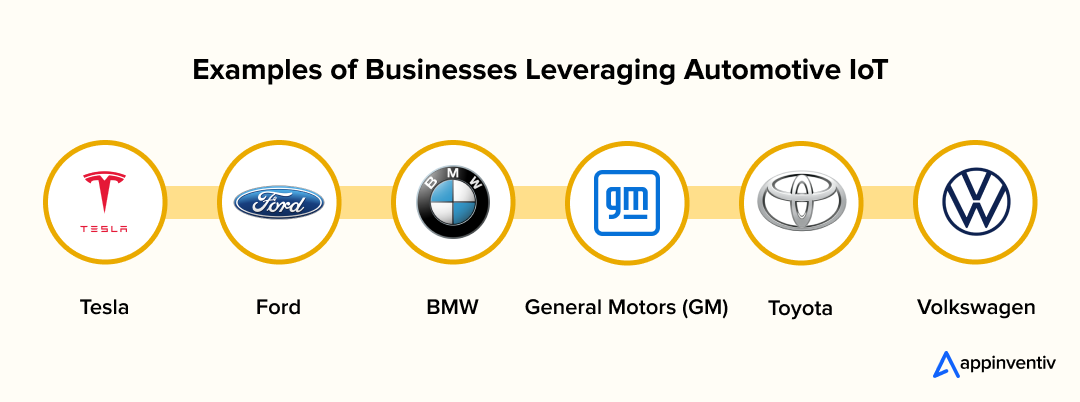
Tesla
Elon Musk’s “Tesla Motors” is a leading electric vehicle manufacturer that has truly leveraged the power of IoT in its cars. Tesla manufacturers integrate IoT sensors in the vehicles, which help collect data based on drivers’ behavior patterns, battery status, vehicle performance, etc. This data is transmitted to Tesla’s servers, where IT experts analyze it to find out any issue and solve it in real-time before it gets critical.
Also Read: Cost to Build an Advanced Driver Assistance System Like Tesla Autopilot
Ford
Ford is another leading automotive company that uses IoT-based solutions to improve the driving experience and vehicle quality. The factories of Ford have IoT sensors that track every stage of the manufacturing process, such as machinery, inventory, and production.
Ford CEO and president Mark Fields has been utilizing IoT solutions to develop autonomous cars for more than a decade. GoDrive and GoPark, (a predictive parking system that directs users to a suitable parking space) and FordPass (a hub for connected car services, such as car sharing, remote locking, vehicle location, etc.) are some other remarkable applications of IoT in Ford service range.
BMW
BMW uses IoT-based solutions to improve vehicle performance and advance the driving experience. In addition, BMW connects its ConnectedDrive services with IFTTT
(If This Then That ) and IoT smart technology, which helps enhance vehicle connectivity.
From supply chain management, predictive maintenance, and operational efficiency to inventory optimizations, BMW leverages the power of IoT to its fullest. In short, BMW has adopted every aspect of IoT in creating the Connected Cars that have revolutionized an individual’s driving experience in the Smart and Connected World.
General Motors (GM)
GM has embedded IoT deeply into its OnStar system, which provides real-time navigation, emergency assistance, remote diagnostics, and stolen vehicle tracking. OnStar constantly collects vehicle data to offer predictive maintenance alerts and faster accident responses. GM is also advancing connected vehicle-to-infrastructure (V2I) communication, which will allow cars to interact directly with traffic signals and road sensors in the future.
Volkswagen
Volkswagen uses IoT to power its Industrial Cloud, connecting more than 120 factories worldwide into a single smart network. This cloud tracks equipment status, energy consumption, and production lines in real time, helping VW improve manufacturing efficiency and reduce costs. On the customer side, Volkswagen is working on connected car services that offer real-time traffic updates, predictive maintenance, and remote vehicle controls.
Toyota
Toyota’s Mobility Service Platform (MSPF) is a great example of how IoT enables a full ecosystem of connected services. The platform integrates telematics, car-sharing apps, ride-hailing services, and fleet management tools, all powered by real-time IoT data. Toyota is also actively using IoT in its production facilities to track equipment health and improve assembly line performance.
Addressing the Challenges of Connected Cars: Effective Solutions and Strategies
Connected cars face several significant challenges, from ensuring robust network reliability to managing vast amounts of data securely. However, implementing the right solution can overcome such challenges. Let’s have a look at major challenges of IoT in the automotive industry:
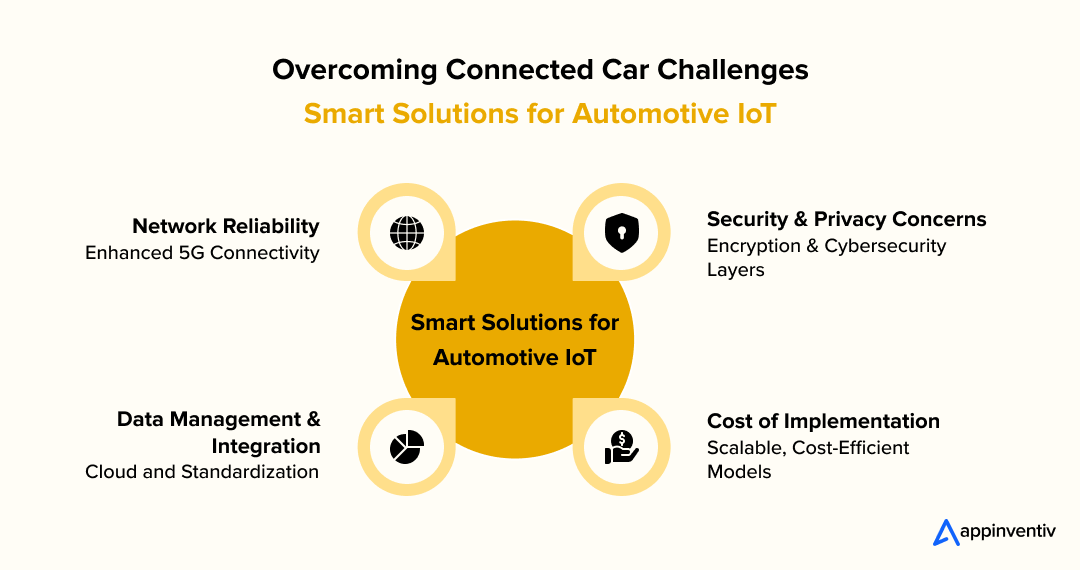
Network Reliability
Unreliable or weak network connections can disrupt essential services like real-time navigation and updates, affecting the driving experience.
Solution: Strengthen network infrastructure with broader coverage and adopt technologies such as 5G to enhance connectivity. Incorporate offline capabilities for critical functions to ensure continuous operation during network interruptions.
Data Management and Integration
The vast volume of data generated by connected cars can overwhelm systems and complicate integration across platforms.
Solution: Use advanced data analytics and cloud-based storage to handle and process large data sets efficiently. Standardize data formats and implement interoperable platforms to facilitate smoother integration.
Security and Privacy Concerns
Connected cars are vulnerable to cybersecurity threats such as hacking and data breaches, which can compromise user safety and privacy.
Solution: Implement strong encryption, conduct regular security updates, and use intrusion detection systems to safeguard against cyberattacks. Ensure regulatory compliance for IoT in the automotive Industry with data protection regulations and perform frequent security audits to enhance privacy.
Cost of Implementation
The high cost of IoT integration into the automotive industry can be a significant barrier for manufacturers.
Solution: Reduce costs by leveraging economies of scale and forming strategic partnerships with technology providers. Focus on scalable solutions and prioritize features that deliver the most value to manage expenses effectively.
Future of Automotive IoT: What Businesses Can Expect
The road ahead for the automotive industry is not just about making smarter vehicles—it’s about creating entire connected ecosystems. Automotive IoT is quickly moving from optional to essential, and businesses that act now will be the ones leading the next wave of transformation.
Here’s what businesses can expect from the future of automotive IoT—and how they can prepare for it.
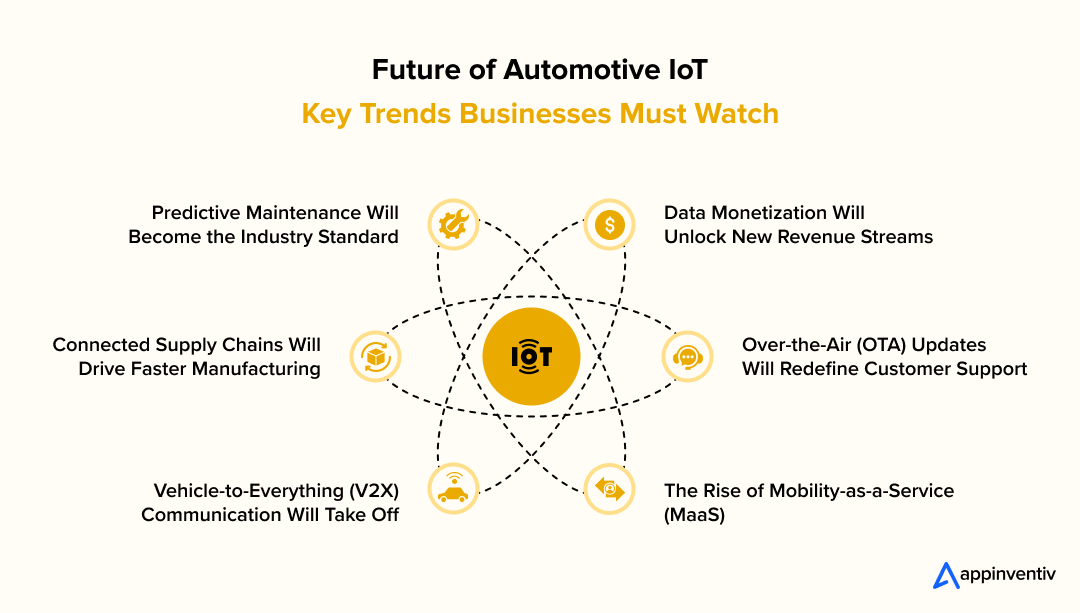
1. Predictive Maintenance Will Become the Industry Standard
As IoT-powered sensors become more advanced, predictive maintenance will no longer be a premium feature—it will be a baseline expectation. Cars will be able to detect early signs of engine trouble, worn-out parts, or battery issues and alert drivers or service centers before a failure happens. This will dramatically cut downtime, reduce warranty costs, and improve customer satisfaction.
Tip:
Businesses should start investing in building predictive maintenance dashboards and connected service platforms that allow real-time data tracking and instant customer communication.
2. Connected Supply Chains Will Drive Faster Manufacturing
Automotive IoT will not stop at the vehicle—it will fully integrate into the supply chain. Smart factories, real-time inventory management, and connected suppliers will make manufacturing faster, more efficient, and highly responsive to demand changes. The ability to track every part, every machine, and every shipment in real-time will transform how cars are built and delivered.
Tip:
Automotive companies should prioritize IoT integration across their entire supply chain, working closely with suppliers and logistics partners to create a real-time, transparent production network.
3. Vehicle-to-Everything (V2X) Communication Will Take Off
In the future, cars will not just talk to each other—they’ll talk to traffic signals, smart roads, parking lots, and even pedestrians’ smartphones. V2X communication will enable safer roads, real-time traffic management, and optimized route planning. It will also open doors for autonomous driving by creating a fully connected driving environment.
Tip:
Businesses should start exploring V2X partnerships with city planners, infrastructure providers, and software developers to position themselves at the center of future smart city ecosystems.
4. Data Monetization Will Unlock New Revenue Streams
As connected vehicles generate massive amounts of data—on driving patterns, vehicle usage, location, and system health—data monetization will become a key growth area. Companies will be able to offer personalized services, targeted insurance plans, location-based promotions, and usage-based billing.
Tip:
Automotive businesses should develop clear data governance strategies now, ensuring compliance while building scalable systems to process, analyze, and monetize vehicle data securely.
5. Over-the-Air (OTA) Updates Will Redefine Customer Support
The ability to remotely update vehicle software will become a norm, allowing manufacturers to add new features, fix bugs, and improve system performance without requiring a visit to the service center. This will shift the way companies handle post-sale customer engagement, making cars feel continuously upgraded.
Tip:
Automakers should design vehicle platforms that can easily support OTA updates and start investing in customer education to build trust in this model of remote vehicle management.
6. The Rise of Mobility-as-a-Service (MaaS)
The future is moving toward shared, flexible mobility solutions where vehicle ownership might no longer be the priority. IoT will power car-sharing platforms, subscription models, and integrated mobility services that combine public and private transportation for seamless urban travel.
Tip:
Businesses should start exploring how they can enter the MaaS ecosystem—either by developing their own mobility platforms or partnering with ride-sharing and public transport providers to offer integrated solutions.
How Appinventiv Can Help Leverage Automotive IoT
As a leading automotive software development services partner, we understand that success in the automotive IoT space isn’t just about technology—it’s about building smart, scalable, and future-ready ecosystems. Our team specializes in developing connected automotive solutions that solve real-world problems and help businesses stay ahead of market shifts.
We bring deep expertise in IoT development services, real-time data processing, and seamless cloud integration, ensuring your vehicles, systems, and supply chains work in perfect sync. Whether it’s predictive maintenance, V2X communication, or OTA updates, we build customized platforms that match your exact business goals.
What sets us apart? We don’t believe in one-size-fits-all. We co-create tailored solutions, offer end-to-end support, and integrate cutting-edge technologies like AI, machine learning, and big data analytics to help you unlock the full potential of automotive IoT solutions.
If you’re looking to tap into new revenue streams, optimize operations, or lead in connected mobility—Appinventiv is the right partner to leverage the power of IoT in the automotive industry. Let’s build the future of smart automotive together.
FAQs
Q. How is IoT used in automotive?
A. The use cases of IoT in the automotive industry are worth remarkable for fleet management, autonomous vehicles, and smart parking. Also, automotive IoT monitors and manages various performance metrics, such as brake wear, engine health, and tire pressure. Additionally, IoT sensors help collect data, which can be further used to improve vehicle efficiency, safety, and overall performance.
Q. What is the impact of IoT on vehicles?
A. The impact of IoT embedded systems on vehicles is influential, enabling them to connect with Wi-Fi and other vehicles on the road. This high level of interconnection leads to improved vehicle performance, enhanced driver experiences, increased safety, and greater efficiency. Additionally, automotive IoT is the driving force for developing autonomous vehicles that can revolutionize how we drive and interact with our vehicles.
Q. What is the future scope of IoT in the automobile industry?
A. The future of IoT in the automobile industry is set to revolutionize how vehicles are built, managed, and experienced. IoT will drive key advancements such as predictive maintenance becoming the industry standard, fully connected supply chains, Vehicle-to-Everything (V2X) communication, and seamless Over-the-Air (OTA) updates. We’ll also see the rise of data monetization and Mobility-as-a-Service (MaaS) platforms, where shared, flexible, and subscription-based vehicle models will become mainstream.
As IoT becomes the backbone of modern automotive ecosystems, businesses can expect smarter manufacturing, safer roads, faster services, and entirely new revenue streams, positioning IoT as a critical growth engine for the industry.
Q. How to ensure real-time data processing and low latency in automotive IoT applications?
A. Real-time processing is essential for safety-critical automotive IoT functions like collision alerts and autonomous driving. To achieve low latency:
- Use edge computing to process data closer to the vehicle.
- Prioritize lightweight communication protocols like MQTT.
- Optimize network selection with 5G or DSRC for faster, more stable connections.
- Implement real-time operating systems (RTOS) for faster task handling.
Q. What are best practices for secure IoT device communication in connected vehicles?
A. Security in automotive IoT is crucial to protect data and prevent breaches. Best practices include:
- Use end-to-end encryption for all data transmissions.
- Implement secure boot and firmware updates to prevent tampering.
- Leverage device authentication and identity management to block unauthorized access.
- Regularly perform security audits and penetration testing to identify vulnerabilities.
Q. Which IoT platforms offer the best integration capabilities with automotive ECUs and sensors?
A. Choosing the right IoT platform ensures smooth integration with vehicle electronics. Top platforms include:
- AWS IoT FleetWise for ECU data collection, edge processing, and fleet management.
- Microsoft Azure IoT Hub for secure, scalable cloud-to-vehicle connectivity.
- Bosch IoT Suite specifically tailored for automotive environments.
- Siemens MindSphere for seamless sensor integration and advanced analytics.
Q. How is advanced technologies integration with IoT transforming the automotive industry?
A. Advanced technologies integration with IoT is reshaping the automotive landscape by making vehicles smarter, safer, and more connected. Key advancements include:
- Artificial Intelligence (AI) for predictive maintenance, real-time decision-making, and personalized in-car experiences.
- Machine Learning (ML) to analyze driving patterns, optimize routes, and enable autonomous driving features.
- 5G Connectivity for ultra-fast, low-latency communication between vehicles, infrastructure, and the cloud.
- Edge Computing to process critical data locally within the vehicle for instant response.
Blockchain for secure, traceable transactions and tamper-proof vehicle data records.


- In just 2 mins you will get a response
- Your idea is 100% protected by our Non Disclosure Agreement.

Developing an IoT-Based Smart Water Management System - Key Benefits, Applications and Process
Think about this: by 2050, the global water demand is set to shoot up by over 50%. That's a lot of water, and frankly, the world needs to be smarter about its use. As a business leader, the strategies you implement today will greatly impact your company's and environment’s future, particularly in terms of sustainability…

Exploring IoT in Telecommunication - Use Cases, Benefits, Challenges, and Strategic Implementation
Telecom is the foundation of modern-day connectivity, supporting the communication networks that keep the world linked. But with the growing dependency of always being on and connected, led by the rapid pace of technological advancement, including 5G deployment, requires telecom operators to adapt quickly. With trillions of connected devices set to enter the digital space…

Top 10 Use Cases and Benefits of IoT Energy Management Changing the Power Industry
The escalating demand for energy consumption worldwide is projected to reach around 800 exajoules by 2050, a big jump from over 600 exajoules in 2019. This fastest-growing global energy use is throwing a major curveball - prioritizing smart energy for waste management. In this pursuit, the rise of the Internet of Things (IoT) offers a…
